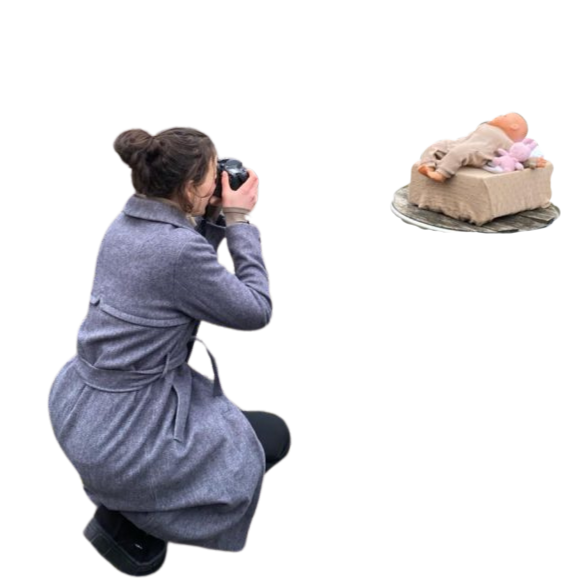
Taking photos of the baby doll to create the 3D model. Created by the authors, 2024.
The process of this 3D model had its challenges, but offered many opportunities for learning and gaining new skills. The 3D model creation process is divided into preparation, material creation, and Metashape processing. First, the preparation steps included applying baby powder and matt spray to reduce reflections, ensuring stability for 360-degree capturing, and creating a baby crib setup. The set up for the photos was another crucial part, as the Baby Doll needed stability that would enable us to capture it clearly from an 360 degree angle. It could not stand or sit on its own, therefore we created a baby crib by ourselves. We learnt that each toy is individual, and needs different solutions. We also challenged our creativitiy by creating a setup.

For the second step, the material creation, we took detailed photos to construct the 3D model. This process involved learning about camera settings and following specific rules like not adjusting the zoom but manually changing the angle. Capturing the toy from all angles was crucial, although challenges came up with maintaining consistent distances and unfortunately, we accidentally changed the zoom. This was a game changer, as we had to start the process all over again. But identifying these errors helped us improve our approach and repeat the steps more effectively. Despite facing weather-related challenges, using a photo box in the second attempt improved the process. The time and precision needed for this step and emphasized the importance of attention to detail in achieving accurate results.

The final step in the process involved creating the 3D model with Metashape, which proved to be the most challenging and time-consuming phase. Despite minor shape issues with the doll, the main challenge was editing the texture imperfections, which required us to edit 138 photo masks. Eventually, the final Baby just needed a smoother texture where the black spots were filled out. This experience showed us the importance of expecting additional work, being prepared for it. Concluded, learning from mistakes was a key aspect of the process, showing the uniqueness and challenges of working with diverse toys. Besides that, having the sessions as a group was highly beneficial, as it allowed us to share our experiences and receivevaluable feedback from our peers.